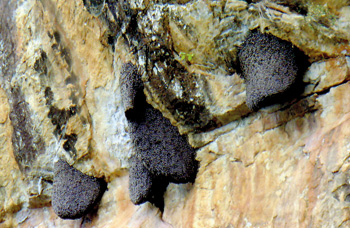| Last year, there were reports that the giant bee hives of Sigiriya had been removed by authorities using various chemicals or local exorcism rites, or shanthi karma.
A series of bee attacks on visitors to this world heritage site last year gave rise to these speculations, but the Sigiriya bees are back again this year re-colonizing the rock. As many as 20 large bee hives can be seen hanging on the rock above the giant ‘sinha padaya’ (Lion’s paw).
According to local guides, the bees started re-colonizing the rock about three months back. They also shrug off speculation that the bee hives were burnt last year. “Nothing like that happened,” says Punchi Bandara, a local guide who acts as a translator for foreign visitors to the site. Punchi Bandara who lives in a village closeby and has been a guide for 30 years said such a move could not have happened without the villagers becoming aware of it.
 |
| The Beehives close to the Lions Paw |
He said that the Sigiriya bees are seen on the rock only during particular months of the year. They settle on the rock during the dry season and move to the dense forest below after the rains start.
According to this veteran guide, there were three main reasons for the bees to get disturbed. One was the noise caused by the visitors, particularly when climbing the steps adjacent to the area where the hives hung from the rock; secondly white uniforms, worn by students that reflected light; thirdly the presence of the ‘gale kurulla’ (bird on the rock) – a raptor that attacked hives.
Giving a scientific explanation, Dr.R.W.K. Punchihewa, a veteran on bees said these bees were a migratory species on the move towards the hill country from the coastal zones. He said their journey coincided with the seasonal flowering of some plants such as Nelu. He said they arrive usually around January-February and start moving further south from July onwards.
Bees in Sigiriya are a species known as Rock Bees or Giant Honey Bee scientifically categorized as Apis dorsata. Referred to as ‘Bambara’ in Sinhala, they feed on pollen and nectar of flowers. But these Giant Honey Bees are also mistakenly commonly referred to as wasps and debara in Sinhala, which is a carnivore that feeds on other insects.
Since the recent colonization, no bees attacks have been recorded the local guide said. He said two years ago a child died due to an attack by the bees and there were occasions they had to assist stranded visitors on the rock during an attack. Although there is an enclosure covered by mesh (bee hide) close to the Lion’s Paw where the visitors could find safety during an attack it was too small to accommodate the crowd he said.
As a solution to the problem, Dr.Punchihewa suggests an ecological barrier. These bees fly downward in search of flowers encountering humans on their route. When a bee is accidentally killed, it emits a chemical known as Pheromones that signals trouble to the other soldier bees. This warning triggers a swarm of attack where bees sacrifice themselves in order to protect their hives.
Bees die after one single sting, as their venom sac detaches from their body with parts of the abdomen). Dr.Punchihewa suggests planting some trees etc. to alter their flight path to minimize encounters with human beings. However, these suggestions have not been acted upon and so the problem continues, he said.
In case of an attack
The key is not to panic. A large percentage of those admitted to hospital after an attack are those who have sustained injuries caused by falls. If you are stung, the tubular tooth should be removed as quickly as possible to avoid venom entering the body.
This also helps to deter other bees who will continue to swarm around the victim attracted to the Pheromone chemical that continues to be emitted. When removing the tubular tooth, you should be careful not to squeeze the venom gland, as it will make the injection of the venom faster. |


